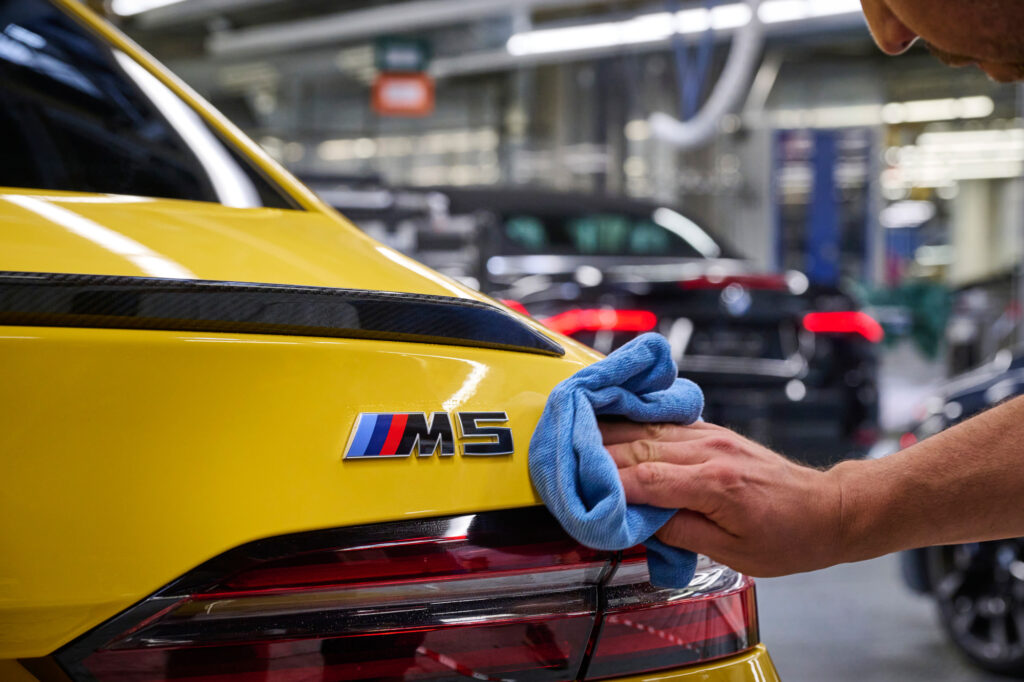The recently announced 2025 BMW M5 started rolling off the assembly line at BMW Group Plant Dingolfing. The M Hybrid luxury sports car combines the quick power of an EV with the steady V8 engine gives the new sedan increases in horsepower and sprint-speed over prior models. It does, however, get something of a weight penalty, adding 1000 pounds to it’s heft over the 2024 model
Read BMW’s full release about the assembly start for the new M5.
Dingolfing. A few days ago, BMW M GmbH unveiled the new BMW M5 (Energy consumption, weighted, combined: 1,7 – 1,6 l/100 km [166.2 – 176.6 mpg imp] and 25,5 – 25,0 kWh/100 km according to WLTP; CO2 emissions, weighted, combined: 39 – 37 g/km according to WLTP; fuel consumption with discharged battery: 10,3 – 10,2 l/100 km [27.4 – 27.7 mpg imp] according to WLTP; CO2 classes: weighted, combined B, with discharged battery G) and released the first official pictures. Today, the new high-performance sedan celebrated its official start of production at BMW Group Plant Dingolfing. The seventh-generation BMW M5 is the first to come off the assembly line with an electrified drive train: The model-specific M HYBRID system combines a V8 engine with an e-drive to deliver a system output of 727 hp, enabling it to sprint from 0 to 100 in just 3.5 seconds. The vehicle’s high-voltage battery, with an available energy content of 18.6 kWh, offers an electric range of 67 to up to 69 kilometres (WLTP) that is unique among its competitors.
“We are proud to be building the latest generation of the iconic M5 here in Dingolfing,” says Plant Director Christoph Schröder. The site already delivered the pre-assembled bodies for the very first BMW M5 models, back in the 1980s, which were then completed by hand at M GmbH in Garching. Since the second generation – or, to be more exact, 1988 – the high-performance sports car has been built entirely at the plant in Lower Bavaria.
Central components for the new BMW M5 are also produced on site or supplied by nearby component plants. Schröder refers to this as an “under on roof production approach”. For example, the chassis of the BMW M5, specially tailored to the model, comes from Dingolfing component plant 02.10, while the high-voltage battery is assembled next door at plant 02.20, the Competence Centre for E-Drive Production. The carbon-fibre roof is supplied by the plant in Landshut, located 30 kilometres away.
A unique aspect of production at the vehicle plant is the modifications already made in the body shop. Based on the BMW 5 Series standard production body, the BMW M5 features additional measures to stiffen the body structure and a specially widened body with flared wheel arches, thus also enabling the integration of the M-specific rear axle.
In the paint shop, customers can choose between ten standard and 150 special-request finishes for their new BMW M5.
The new BMW M5, like its predecessor, is assembled alongside other BMW 5 Series, BMW 4 Series and BMW M4 models on the same production line, where it is completed with specific equipment options, such as the CFRP rear spoiler, M steering wheel and M multifunction seats.
Over the coming weeks, production at the plant will gradually ramp up to several dozen BMW M5 vehicles per day. The European market launch of the new model is scheduled to get underway from 2 November 2024. By then, another new model will already be celebrating its premiere at Plant Dingolfing: the new BMW M5 Touring, which expands the BMW M GmbH offering and completes the new BMW 5 Series range.
Tags: 2025 M5 production start